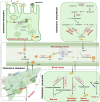Cholesterol metabolism: molecular mechanisms, biological functions, diseases, and therapeutic targets
- PMID: 41062796
- PMCID: PMC12508344
- DOI: 10.1186/s43556-025-00321-3
Cholesterol metabolism: molecular mechanisms, biological functions, diseases, and therapeutic targets
Abstract
Cholesterol, an indispensable structural and signaling lipid, is fundamental to cellular membrane integrity, steroidogenesis, and developmental morphogen pathways. Its homeostasis hinges on the precise coordination of four interdependent metabolic modules: de novo biosynthesis, intestinal absorption, enzymatic conversion, and systemic clearance. This review delineates the molecular machinery governing these processes-from the Bloch/Kandutsch-Russell synthesis pathways and niemann-pick C1-like 1 (NPC1L1)-mediated cholesterol uptake to cholesterol 7α-hydroxylase (CYP7A1)-driven bile acid synthesis and HDL-dependent reverse transport. We further elucidate cholesterol's multifaceted roles in lipid raft assembly, Hedgehog signal transduction, and vitamin D/hormone production. Critically, dysregulation of cholesterol flux underpins pathogenesis in atherosclerosis, metabolic dysfunction-associated fatty liver disease (MAFLD), neurodegenerative disorders, and oncogenesis, with disrupted synthesis, efflux, or esterification cascades serving as key drivers. Emerging therapeutic strategies extend beyond conventional statins and proprotein convertase subtilisin/kexin type 9 (PCSK9) inhibitors to include transformative modalities: CRISPR-based in vivo gene editing (e.g., VERVE-101 targeting PCSK9), small interfering RNA (siRNA) therapeutics (inclisiran), and microbiota-directed interventions. Pioneering approaches against targets Such as angiopoietin-like 3 (ANGPTL3), lipoprotein(a) [Lp(a)], and asialoglycoprotein receptor 1 (ASGR1)-alongside repurposed natural agents (berberine, probiotics)-offer promise for mitigating residual cardiovascular risk and advancing precision cardiometabolic medicine. By integrating mechanistic insights with clinical advancements, this review underscores the transition from broad-spectrum therapies to personalized, multi-target regimens, offering a roadmap for mitigating cholesterol-related diseases in the era of genomic and metabolic medicine.
Keywords: Cholesterol homeostasis; Cholesterol-lowering therapy; Cholesterol-related diseases; Metabolism regulation; Signal transduction; Steroid hormone.
© 2025. The Author(s).
Conflict of interest statement
Declarations. Ethics approval and consent to participate: Not applicable. Consent for publication: The authors consent to the publication of this work. Competing interests: The authors declare that they have no conflict of interests.
Figures






References
-
- Schade DS, Shey L, Eaton RP. Cholesterol review: a metabolically important molecule. Endocr Pract. 2020;26(12):1514–23. 10.4158/Ep-2020-0347. - PubMed
-
- Wu Y, Yang S, Zhang Y, Su Z. Exosomes in metabolic diseases: from molecular mechanisms to clinical applications. MedComm – Future Medicine. 2025;4:e70031. 10.1002/mef2.70031.
-
- Huang BL, Song BL, Xu CQ. Cholesterol metabolism in cancer: Mechanisms and therapeutic opportunities. Nat Metab. 2020;2(2):132–41. 10.1038/s42255-020-0174-0. - PubMed
-
- Saher G. Cholesterol metabolism in aging and age-related disorders. Annu Rev Neurosci. 2023;46:59–78. 10.1146/annurev-neuro-091922-034237. - PubMed
-
- Li H, Yu XH, Ou X, Ouyang XP, Tang CK. Hepatic cholesterol transport and its role in non-alcoholic fatty liver disease and atherosclerosis. Prog Lipid Res. 2021. 10.1016/j.plipres.2021.101109. - PubMed
Publication types
MeSH terms
Substances
Grants and funding
LinkOut - more resources
Full Text Sources
Medical
Miscellaneous
